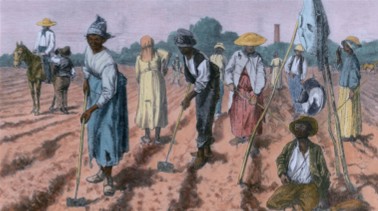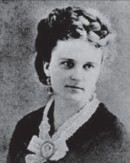
Think about the following questions.
1. Do you know anyone who has a multiracial (mixed-race) background?
2. In the past, how were multiracial people treated by society?
3. How are multiracial people treated by society today?
VOCABULARY PREVIEW
Match each New Academic Word List(NAWL) word with the correct definition.
- slavery
- grasp _____
- vein _____
- plantation _____
- conscious _____
- utterance_____
- a. to take and hold something with your hand or hands
- b. aware
- c. the act of making a particular sound with one's voice; something said
- d. a large area of land where crops are grown
- e. the state of being a slave
- f. any one of the tubes that carry blood from parts of the body back to the heart
"DÉSIRÉE'S BABY" BY KATE CHOPIN
[excerpted and adapted]

Désirée sat in her room one hot afternoon. The baby lay asleep upon her own great mahogany1 bed. One of the slaves stood fanning the child. Désirée's eyes had been fixed absently and sadly upon the baby. She looked from her child to the boy who stood beside him and back again. "Ah!" It was a cry that she could not help, and she was not conscious of having made the utterance. The blood turned like ice in her veins, and moisture gathered upon her face. She stayed motionless2, with her eyes riveted upon her child and her face full of fear.
Presently, her husband entered the room and without noticing her, went to a table and began to search among some papers. "Armand,” she called to him. But he did not notice. "Armand," she said again. Then she rose and tottered3 toward him. "Armand," she cried once more, grasping his arm, "look at our child. What does it mean? Tell me."
"It means," he answered lightly, "that the child is not white; it means that you are not white."
When she could hold a pen in her hand, she sent a despairing4 letter to her mother, Madame Valmondé.
"My mother, they tell me I am not white. For God's sake, tell them it is not true. I will die. I must die. I cannot be so unhappy and live."
The answer that came was brief:
"My own Désirée: Come home to Valmondé, back to your mother who loves you. Come with your child.”
When the letter reached Désirée, she went with it to her husband's study, and laid it open upon the desk before which he sat.
He said nothing. "Shall I go, Armand?" she asked in a voice sharp with agonized5 suspense6.
"Yes, go."
"Do you want me to go?"
"Yes, I want you to go."
She turned away as if stunned by a blow and walked slowly toward the door, hoping he would call her back.
"Good-bye, Armand," she moaned.
He did not answer her.
Désirée went in search of her child. The nurse, Zandrine, was walking around the gallery with the baby. She took the little one from the nurse's arms and, descending the steps, walked away.
Désirée had not changed the thin white dress nor the slippers which she wore. She did not take the broad road which led to the far-off plantation of Valmondé. She walked across a deserted field, where the stubble bruised her tender7 feet and tore her white gown to shreds8. She disappeared among the grasses that grew thick along the banks; and she did not come back again.
Several weeks later there was an unusual scene at the house. In the center of the backyard was a great bonfire9. Armand Aubigny sat in the wide hallway that offered a view of the sight; and it was he who handed out to a half-dozen slaves the material that kept this fire burning.
The last thing to go into the fire was a tiny bundle of letters that Désirée had sent to him during the days before their marriage. There was the remnant10 of one back in the drawer from which he took them. But it was not Désirée's; it was part of an old letter from his mother to his father. He read it. She was thanking God for the blessing of her husband's love:
"But above all," she wrote, "I thank the good God for having arranged our lives so that our dear Armand will never know that his mother belongs to the race that is cursed11 with the brand12 of slavery."
New Academic Word List
- mahogany 1 : n. a strong reddish-brown wood often used for furniture
- motionless 2 : adj. without moving
- totter 3 : v. to walk unsteadily
- despairing 4 : adj. feeling very sad and without hope
- agonized 5 : adj. showing great pain
- suspense 6 : n. a feeling of nervousness or excitement caused by wondering what will happen
- tender 7 : adj. delicate; easily damaged
- shred 8 : n. a long, thin piece torn off of something
- bonfire 9 : n. a large outdoor fire
- remnant 10 : n. a part of something left when the other parts are gone
- cursed 11 : adj. affected by something bad
- brand 12 : n. a mark; an identity
READING COMPREHENSION
A ‣ Mark each statement as true (T) or false (F) according to the reading.
- Désirée is shocked and confused about how her baby looks.
- True
- False
- Désirée's mother tells her to bring her baby and come home.
- True
- False
- Désirée takes the easiest road when she leaves.
- True
- False
- Armand becomes angry that his slaves started the great bonfire.
- True
- False
- The letter that Armand reads at the end is from Désirée.
- True
- False
B ‣ Choose the best answer according to the reading.
- In paragraph 1, the phrase riveted upon means _____.
- a. avoiding
- b. similar to
- c. afraid of
- d. staring at
- What can be inferred about Armand from the way he treats Désirée?
- a. He does not really want her to leave.
- b. He did not love her when they married.
- c. He believes that whites are superior.
- d. He believes that he is not white.
- What does Désirée do immediately after Armand tells her to go?
- a. She burns all of the letters she wrote to Armand.
- b. She runs away to her mother's house.
- c. She goes looking for her child.
- d. She briefly waits for her husband to change his mind.
- What do we discover about Armand at the end of the story?
- a. His childhood was unhappy.
- b. He is multiracial himself.
- c. He never knew his parents.
- d. His parents were both slaves.
C ‣ Put the events from the story in order (from a to e).
- _____ A bonfire is started in the backyard.
- _____ Armand learns the truth about his own mother.
- _____ Désirée notices something surprising about her baby and becomes worried.
- _____ Armand tells Désirée to leave.
- _____ Désirée writes a letter to her mother and receives a response.
SUMMARY
Fill in the blanks with the phrases in the box.
- tells her to go
- is not white
- only the baby
- she was black
- Désirée's things
- is upset about
|
Beginning
|
| ↓ |
|
Middle
|
| ↓ |
|
End
|
VOCABULARY PRACTICE
Fill in the blanks with the words in the box. Change the form if necessary.
- grasp
- plantation
- utterance
- vein
- conscious
- slavery
- When you give blood, a needle is inserted into a(n) _____ in your arm.
- Many African slaves lived and worked on cotton _____ in the American South.
- I _____ the door handle and pulled as hard as I could, but it wouldn't open.
- The students greatly respected their teacher and listened closely to her every _____ .
- Frederick Douglass was an African American who was born into _____ but later became a free man.
- Alison was so interested in the book she was reading that she wasn't even _____ of the hours passing.
SUPPLEMENTAL READING
Master or Slave?

"Désirée's Baby" was one of Kate Chopin's (1851-1904) first and most famous short stories. In this story, Chopin explores the theme of race more strongly than in any of her other works.
Désirée is married to Armand, who owns a plantation and the many African-American slaves that work on it. This was typical in the southern United States at that time. Black people were brought to America, primarily from Africa, as slaves and then bought and sold like property. White people viewed African Americans as an inferior race, and it was shameful for a white person to have "mixed blood," as would result from having parents of different races.
This explains Désirée's concern after realizing that her son had black features. When Armand told Désirée that "the child is not white" and that "you are not white," he was referring to more than skin color. He meant that his wife and child were inferior and were no longer acceptable to him.
This rejection was more than Désirée could bear, and she felt it was better to die than to live in such disgrace. When she walked away, the bushes tore her white dress, symbolizing that she was no longer a white person.
When Armand discovered the baby's mixed blood came not through Désirée but through his own mother, he had already lost his wife and son, and his life was destroyed.
One critic noted that Armand was as much a slave to his racial views as the real slaves that he controlled. "No real distinction based on color can be made between slave and master."
Fill in the blanks with information from the reading.
- In the US during Kate Chopin's time, whites were ashamed to have parents of _____.
- Armand believed that non-white people were _____.
- As a critic pointed out, Armand was not really free; he was a slave to _____.

Leave a comment
Load more